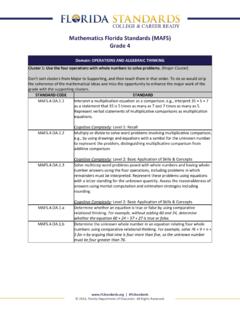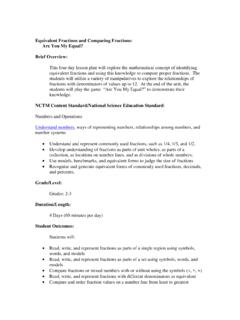Transcription of Stem Sentences. Spine 3: Fractions - Enigma Maths Hub
1 A COLLECTION OF STEM SENTENCES FROM Enigma Maths HUB BASED ON THE NCETM PD MATERIALS. Stem Sentences. Spine 3: Fractions Part-whole relationship Year 3: Unit Fractions Year 3: Non Unit Fractions Year 3: Making a whole Year 3: , Year 4: Counting in fractional steps Year 4: Improper Fractions and mixed numbers Year 3: , Year 4: Equivalent Fractions Year 5 Simplifying Fractions Year 5: comparing Fractions Year 3 , Year 5 Adding and subtracting Fractions Year 3: , , Year4: , , Year 5: Multiplying whole numbers and Fractions Year 4: , Year 6: Dividing Fractions Year 6: Linking Fractions , decimals and percentages Year 6: Part-Whole relationships PD Example of stem sentence Type of stem Examples from the NCETM PD Materials Link sentence Year 3: If _____ is the whole then Structure _____ is part of the whole.
2 1:1. 1:4. If Europe is the whole , then the United Kingdon is part of the whole. If the week is the while then Tuesday is part of the whole Year 3: A part is always smaller than Generalisation the whole. 1:5. Year 3: If _____ is the whole then Structure If my face is the whole then my foot is not part of the _____ is not part of the whole. 1:7 whole. Year 3: The whole has been divided Structure /. into ___ equal / unequal language 2:2 parts. Year 3: The whole has been divided Structure into ___ equal parts. 2:3. The whole has been divided into 4 equal parts. A COLLECTION OF STEM SENTENCES FROM Enigma Maths HUB BASED ON THE NCETM PD MATERIALS. Year 3: The parts are equal, I know Structure this because the number of 2:6 ___ in each part is the same. Year 3: The parts are unequal, I Structure /.
3 Know this because the language 2:6 number of ____ in each part is not the same. Year 3: Equal-sized parts do not Generalisation have to look the same. 2:7. Year 3: different parts of the same- Generalisation sized whole can be directly 3:2 compared based on their size. In the first set of counters, the yellow counters make up a smaller part of the whole then in the second set. Year 3: As the while increases in size Generalisation and the size of the selected 3:4 part remains the same, each part becomes smaller in relation to the whole. Unit Fractions Year 3 A unit fraction is any Generalisation 3:2 fraction where the 2:1 numerator is one. Year 3: The whole has been divided Structure /. into ___ equal parts language 2:1 ___ of the parts has been shaded. The whole has been divided into three equal parts.
4 One pf the parts has been shaded. Year 3: Language /. structure 2:2. A COLLECTION OF STEM SENTENCES FROM Enigma Maths HUB BASED ON THE NCETM PD MATERIALS. Year 3: The denominator is ___ Structure because the whole is divided 2:2 into ___ equal parts. The numerator is one because one part is shaded. The denominaor is 4 because the whole is divided into 4. equal parts. The numerator is 1 because one part is shaded. Year 3: The whole has been divided Structure into __ equal parts. 3:1 Each part is one ___ of the whole. ___ of the whole ribbon has been cut off. Year 3: The whole has been divided Structure into __ equal parts. 3:2 One of these parts is The whole has been divided into 5 equal parts. highlighted. This part is one One of these parts is highlighted. This part is one fifth of ___ of the whole line.
5 The whole line. Year 3: The whole has been divided Structure into ___ equal parts. 3:6 One of these parts in one ___ of the whole. Year 3: When the whole is the Generalisation same, the greater the 5:1 number of equal parts, the smaller each equal part is. When the whole is the same, the smaller the number of equal parts, the bigger each equal part is. Year 3: When comparing unit Generalisation Fractions , the greater the 5:1 denominator, the smaller the fraction. A COLLECTION OF STEM SENTENCES FROM Enigma Maths HUB BASED ON THE NCETM PD MATERIALS. Year 3: When we compare Generalisation Fractions , the whole has to 5:4 be the same. Year 3: If one ____ is a part, then Structure the whole is __ times as 6:4 much. Take ___ parts and put them together to make a whole. Non- Unit Fractions Year 3: I have ____ one tenths.
6 I Structure /. have ___ tenths. language 1:4. Year 3: There are ___ equal parts in Structure /. the whole. There are __ language parts shaded. ___ is shaded. Year 3: The whole has been divided Structure /. into ___ equal parts. language 2:1 ___ of the parts are shaded. That is _____ of the whole. Year 3: The whole has been divided Structure /. into ____ equal parts. language 2:5 ___ of the parts have been shaded; that is ___ of the whole. The whole has been divided into 7 equal parts. 5 of the parts have been shaded; that is 5/7 of the whole. A COLLECTION OF STEM SENTENCES FROM Enigma Maths HUB BASED ON THE NCETM PD MATERIALS. Year 3: The denominator is ___ Structure /. because the whole has been language 2:7 divided into ___ equal parts. The numerator is ___. because ___ of the parts have been identified.
7 The denominator is 5 because the whole has been divided into 5 equal parts. The numerator is 3 because 3 of the parts have been identified. Making a whole Year 3: When the numerator and Generalisation the denominator are the 3:3 same the fraction is 6:1 equivalent to one whole. Year 4: If we know the size of a unit Generalisation fraction, we can work out 5:1 the size of the whole. Year 4: Divide by the numerator to Generalisation find one part. Multiply the 5:11 denominator to find the 8 2=4. whole. 4 x 3 = 12. Counting in fractional steps Year 4: The line is divided into __ Structure equal parts. This allows us to 2:3 count in ___. Year 4: The interval is divided into Structure __ equal parts. This allows us 2:4 to count in ___. A COLLECTION OF STEM SENTENCES FROM Enigma Maths HUB BASED ON THE NCETM PD MATERIALS.
8 Improper Fractions and mixed numbers Year 3: Quantities made up of both Generalisation whole numbers and a 1:2 fractional part can be expressed as mixed numbers. Year 3: Each whole is divided into Structure/. four equal parts. We have __ language 5:4 of these equal parts. |This 5:5 represents ___ quarter(s) Each whole is divided into four equal parts. We have 11 of 5:6 these equal parts. This represents 11 quarter(s). Year 4: The denominator is ___. This Structure/. means that each whole has language 5:8 been split into __ equal parts. __ parts make each whole. The numerator is ___. This means there are ___ equal parts. It is possible to make ___ full The denominator is 4. This means that each whole has groups of ___ quarters and been split into 4 equal parts. 4 parts make each whole. there are ___ more quarters.
9 The numerator is 10. This means there are 10 equal parts. It is possible to make 2 full groups of 4 quarters and there are 2 more quarters Year 4 Our unit is ___ so we will be Structure /. thinking about groups of language 5:13 ____. There are _____ in one whole. Year 4: How many groups of in Structure /. language 5:14. ___ groups and ___ more ___. Year 4: There are ___ groups of ___ Structure /. sixths which is ___ sixths and language 5:16 __ more sixths, so that is ___. sixths A COLLECTION OF STEM SENTENCES FROM Enigma Maths HUB BASED ON THE NCETM PD MATERIALS. Equivalent Fractions Year 5: When two or more Fractions Generalisation have the same value. We 1:9 call them equivalent Fractions . Year 5: The numerator has been Language / The numerator has been scaled scaled up/down by _____ structure up by 4.
10 2:12 The denominator has been The denominator has been scaled up/down by ___ scaled up by 4. These Fractions are /are not These Fractions are equivalent. equivalent. Year 5: Language /. structure 2:16. Year 5: Language /. is equal because both structure 2:20 the numerator and denominator have been scaled by a factor of ___. Year 5: When the numerator and Generalisation denominator are multiplied 2:21 or divided by the same number, the value of the Fractions remains the same. Simplifying Fractions Year 5: The highest common factor Language / The highest common factor is 4 so is ____so divide the structure divide the numeraotr and denominator numerator and denominator by 4. by ____. Year 5: A fraction can be simplified Generalisation when the numerator and 3:5 denominator have a common factor other than one.







